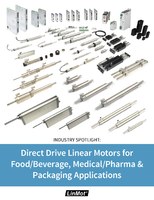Refrigeration Dryers provide 90 m³/min flow capacity.
Press Release Summary:

Characterized by low pressure differential, TG and TI Series can be equipped for air or water cooling of refrigerant condenser. Control system combines refrigerant compressor with variable volume compression chamber, compressed air temperature sensors, and PLC. To save energy, consumption is directly proportional to airflow through dryer and sinks during time of reduced demand. Copper heat exchanger and condensate separator ensure that discharged air meets quality requirements of ISO 8573-1.
Original Press Release:
Even More Savings in Compressed Air Drying
Kaeser's new refrigeration dryers with up to 90 m³/min flow capacity
Refrigeration drying is generally the most economic method of removing moisture from compressed air prior to use and the application of modern energy-saving techniques continue to reduce running costs even further.
For some years, Kaeser Kompressoren have offered a range of such dryers with capacities up to 21 m³/min featuring the energy-thrifty 'Secotec' control system. Larger machines, with capacities from 24 to 90 m³/min are fitted with an extremely efficient refrigerant compressor and a new control system.
The new series of refrigeration dryers, with model designations 'TG' to 'TI', are characterised by very low pressure differential, which means the additional pressure needed by the compressor to overcome the resistance in the dryer is significantly reduced. This reduction has a drastic effect on the energy consumed by the compressor with consequent savings in running costs. Reducing the pressure generated by the compressor by even 0.5 bar reduced the energy consumption by a significant three percent!
New developments in refrigerant compressor design bring additional energy savings. Now, consumption is directly proportional to airflow through the dryer and sinks during times of reduced demand. With no air being dried, no energy is being consumed. For example, if the volume of air flowing through the dryer is only 30 percent of the machines drying capacity, then only 32 percent of the dryer's rated consumption, at maximum, is needed. In comparison with dryers using the common hot gas bypass regulation method, this would represent a massive energy saving in the region of 60 percent!
The new control system is a combination of a refrigerant compressor with variable volume compression chamber, compressed air temperature sensors and a programmable logic controller. The temperature of the incoming compressed air is measured and the information used to control a pulsing solenoid valve that varies the size of the compression chamber in the refrigerant compressor. This in turn affects the power consumption of the motor driving the compressor so that less is needed when the machine is only partially loaded. Annual savings can run into thousands of euros.
A high quality heat exchanger in copper and a very effective condensate separator ensure that the discharged compressed air reliably meets the quality requirements of ISO 8573-1, with solid particle remainder to class 2, moisture content to class 4 and oil residue to class 3.
For application demanding even purer air an appropriate Kaeser filter can be installed to achieve solid particle class 1, moisture class 4 and oil residue class 2.
The new range of dryers can be delivered equipped for air or water cooling of the refrigerant condenser.
Yet another feature of Kaeser's refrigeration dryer is ease of maintenance with ready access to all components such as the ECO-DRAIN automatic, electronic condensate drain that needs occasional observation or maintenance. This, and all other electronic devices, naturally conform to EN 60204.
Users of larger compressed air supply systems can significantly reduce running costs with the Kaeser range of refrigeration dryers designated 'TG' to 'TI' with capacities from 24 to 90 m³/min.




